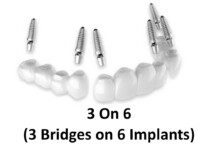
With all of the changes dentistry has seen over the past 50+ years, you would think that dental insurance would be changing to keep up with the times, but, sadly, that is just not true. Little has changed, (with the exception of how successful they have become in controlling the dental marketplace.) I would estimate that 50% of our patients have some form of dental insurance, yet few really understand what this really means, and the limitations most coverages include.
In the realm of dental health, understanding the nuances of insurance coverage for specific treatments like dental implants is crucial. Dental implants, a sophisticated and often necessary procedure for many, present a unique set of challenges when it comes to insurance policies. This article delves into the complexities of insurance coverage for dental implants, offering a comprehensive guide to policy coverage, limitations, and factors influencing insurance decisions. It serves as an essential resource for anyone considering dental implants, providing insights into the often-confusing world of dental insurance and how it applies to this specific dental treatment.
A few of the facts:
- In the 1960s, the annual maximum payout per person on a dental plan was about $1,000. Today, almost 60 years later, for the vast majority of them, it is still only about $1,000. Pathetic, isn’t it? Sadly, this annual “maximum” is easily reached if you need any restorative procedures in addition to your routine cleaning and checkups. With the costs being higher now than they were when these plans were designed and these initial limits set, after they pay for 2 cleanings/year, x-rays and an exam, having even just a single crown can easily put you over your limit.
- In the average indemnity plan, patients only see about 65 cents in return for every dollar in premium paid. The rest goes to the insurance company’s cost of doing business, salaries, profits, etc.
- Insurance companies are in the business of making money, not providing dental care. Providing dental care is only incidental to why they exist!
- Insurance companies have HUGE profits. Their CEOs are among the top paid execs. How is that? Well, it’s simple, actually. That’s because the money coming IN is always more than the money going OUT.
- No dental insurance company has ever lost a nickel on a dental plan. There are so many limitations, deductibles, and co-pays built into their plans that they can’t lose money! They designed the plans in THEIR favor to ensure that they would profit. And the only way to do that, is to collect more from you than they pay out for you. It just makes sense.
- “Insurance” is intended to cover your expenses with catastrophic problems (i.e., Flooding, Hurricane damage, Fire damage, etc.). Most of us pay, for example, Homeowner’s insurance premiums every year for our entire lifetime and never actually receive a dime worth of benefits (that is, if we are lucky enough to NOT have these types of catastrophes!) There is NO comparable “catastrophic” downside in dentistry.
- Clearly, because the cost of providing dental care being so high, the main purpose of dental insurance is not to cover dire issues, like most people think, but more to help prevent them — by encouraging regular maintenance, which is the one good thing they ensure.This is why they do cover the “little things”: Cleanings, exams. It’s kind of like AAA for your mouth. They will cover the preventive cleanings, exams, and less expensive things like fillings, but then they’ll nickel and dime you to death overpaying for the types of procedures typically needed by adults, like crowns or implants. And then! Often, even then, they dictate what materials must be used, or put a flat dollar limit on what they’ll pay for it, increasing your out of pocket expense for the level of care you have available, versus what they will pay for. For example, many current plans do not cover porcelain crowns on teeth further back than your canines. (Yes, you read that right.) They’ll often only pay for metal crowns there. Because they are not “in the smile line”! So, they are dictating your treatment. Another common limitation, is that if you lose a tooth, and don’t want to file down two otherwise perfectly healthy teeth (in front of and behind the missing tooth) to replace it with a bridge, and instead you opt for the “standard in care” today (a dental implant and crown), they won’t pay for the implant or the abutment, but some plans may pay a small portion of the crown for it. Another common limitation: You have to be on the plan for a full year before they allow benefits for “major” treatment (crowns, implants, dentures, etc.) So, they’re getting their money first, you can be sure of that.
- Unlike most medical insurance plans, (who will cover everything from MRI, Colonoscopies, and tons of various types of diagnostic tests almost without question) dental insurance does a relatively bad job of ensuring that adults get the dental care they need. The American Dental Association Health Policy Institute did a survey in which the results clearly showed that cost is THE TOP REASON adults give for not going to the dentist. What is interesting, though, is that this is true even among adults who DO HAVE private dental insurance! And comparing dental insurance to insurance for other types of health care services illustrates just how badly dental insurance performs in providing any real financial protection. Dental care consistently ranks number 1 in terms of health care services that people delay or avoid because of cost, as affirmed in multiple studies from multiple data sources. Even for health care services with benefit structures similar to those of dental care—for example, vision care—financial barriers are far less severe.
Insurance Basics
Insurance coverage for dental implants varies depending on the specific insurance plan and provider. It’s essential to understand the basics of how insurance works in this context.
- Policy Coverage and Limitations: Many dental insurance policies categorize treatments into preventive, basic, and major procedures. Dental implants are typically considered “major” procedures. However, not all policies include them in their coverage. Some insurers might offer implant coverage but with limitations, such as covering only a portion of the cost or setting a maximum benefit limit or maximum number of implants covered in a policy year.
- Waiting Periods: Insurance policies often have waiting periods, which is the time you must wait after buying the policy before coverage for certain procedures kicks in. For major procedures like dental implants, this waiting period can be significant, sometimes up to a year or more. This means you’ll be paying on that policy for a long time before they allow any possible coverage for dental implants.
- Annual Maximums: Virtually ALL dental insurance plans have an annual maximum benefit amount. It is extremely rare that this I not the case. This is the maximum total amount the policy will pay for dental care in a given year, no matter how much dental work you have done that year. Since dental implants can be expensive and the cost exceeds the annual maximum, this leaves the patient to pay the bulk of the cost.
- Pre-existing Conditions (Like the Missing Tooth Clause): Some insurance policies exclude pre-existing conditions from any coverage. A common one is the “missing tooth clause”. With this clause, if tooth is missing before obtaining the insurance, some insurers might not cover the implant OR the crown for that particular tooth.
- Alternative Benefits: Some policies offer an “alternative benefit” clause. For example, if an implant is the recommended treatment, the insurance might only cover the cost of a less expensive procedure, like a bridge or partial denture, or they may only cover the crown that goes on it.
- Medical vs. Dental Insurance: In certain cases, medical insurance might cover dental implants, especially if the need for implants is linked to a medical condition or an accident. It’s essential to check both medical and dental policies.
- Consultation with Insurance Providers: It’s crucial to directly consult your insurance provider to understand the specifics of your coverage. Insurance plans can vary greatly, and the only way to know for sure what is covered is by talking directly to your insurer or reading the policy documentation thoroughly.
Factors Influencing Coverage
When exploring whether insurance covers dental implants, several factors influencing coverage are crucial to consider:
- Type of Insurance Plan: The extent of coverage for dental implants can vary significantly between different types of insurance plans.
- Policy Limitations: Each insurance policy has its own limitations. Some may cover a portion of the cost of dental implants, while others might exclude them entirely. It’s important to read the fine print of your policy to understand what is and isn’t covered.
- Pre-existing Conditions (Like the Missing Tooth Clause): If your policy includes a missing tooth clause, the cost for replacing any teeth that were already missing when you purchased the policy will not be covered at all.
- Annual Maximums: Dental insurance plans have an annual maximum coverage limit. Nowadays, it’s usually between $1,000 a year to $2,000 a year. Since dental implants can be costly, they tend to exceed these annual limits, leaving the patient to pay the remainder out-of-pocket. A single dental implant, if covered, will surely use your entire annual maximum benefit. (Remember, these maximums are also used to pay for routine care like exams, cleanings and x-rays.)
- Waiting Periods: Many insurance plans include a waiting period for certain procedures. This means that coverage for dental implants might not be available until a specified time period has passed after the start of the policy.
- Dentist’s Network: If your policy is not one that allows you to see any dentist you choose, whether your dentist is in their network can also impact coverage. For example: If you have a DHMO (Dental Health Maintenance Organization), you only have coverage if you see someone from their list of providers. You cannot go to anyone you choose. With A PPO (Preferred Provider Organization), you can choose to go outside of the network of their preferred dentists (“preferred” because they’ve contracted to provide treatment at lower than normal, policy-dictated fees). Out-of-network procedures often have higher out-of-pocket costs. It is important, though, to choose your implant doctor because of their experience, credentials, etc, and not by the insurance policy limitations. If you think about it, if you need full mouth treatment, with a maximum benefit of only $1,000-$1,200 a year, which is a small percentage of overall treatment costs, you could be making a mistake you can never remedy. So don’t let your dental benefits dictate your treatment OR your surgeon.
- Alternative Treatments: As mentioned earlier, if a less expensive treatment is available for a procedure you’re having done, this will affect your total out-of-pocket cost. This may include things like coverage for a metal crown vs a porcelain/high noble metal crown (which is much less expensive, but not the “standard of care”.)
Partial vs. Full Coverage
Insurance might cover part of the cost of dental implants in certain situations, such as when an implant is medically necessary. Full coverage is less common but might be possible in specific scenarios, such as if the implant is a result of an accident covered by the plan.
Reading the Fine Print
Understanding the specifics of a dental insurance policy is crucial. This includes being aware of:
- Exclusions:Certain procedures or conditions that are not covered.
- Waiting Periods:The time one must wait before being eligible for certain benefits.
- Pre-existing Condition Clauses:Limitations or exclusions based on dental issues that existed before purchasing the policy.
- Annual Maximums:These caps can significantly impact the coverage for costly procedures like implants.
Questions to Ask Your Insurance Provider
When considering dental implants, it’s important to ask your insurance provider specific questions:
- Do you cover dental implants?
- Is there a waiting period for implant coverage?
- What percentage of the implant cost is covered?
- Are bone grafts covered, if needed?
- Is there a maximum number of implants covered in a given year?
Tips for Navigating Insurance Claims
When exploring whether insurance covers dental implants, it’s crucial to understand the intricacies of insurance policies and how to effectively navigate insurance claims. Our office is happy to submit claims on your behalf (for your reimbursement). Here are some key tips about navigating the claims process:
- Understand Your Policy: Begin by thoroughly reviewing your dental insurance policy. Look for specific mentions of dental implants. Some policies may cover them under major dental services, while others might exclude them altogether. Be aware of any clauses regarding pre-existing conditions or waiting periods that could affect your eligibility for implant coverage.
- Direct Communication with Insurance: Contact your insurance provider directly to inquire about coverage for dental implants. Ask specific questions like the percentage of the cost they cover, any limits on the amount they will pay, and the number of implants covered in a given period. Document these conversations for future reference, noting down the date, the representative’s name, and the key points discussed.
- Medical vs. Dental Insurance: Sometimes, medical insurance may cover certain aspects of the dental implant procedure, especially if the need for implants is linked to medical conditions like accidents. It’s worth exploring your medical insurance policy for potential coverage. In a small percent of cases, they are covered.
- Appealing Denials: If your claim is denied, you have the right to appeal. Carefully review the denial letter to understand the reasons for rejection. You can then gather supporting documents, such as letters from your dentist or medical records, to build a case for appeal. Keep track of deadlines for submitting appeals.
- Flexible Spending Accounts (FSAs) and Health Savings Accounts (HSAs): If you have an FSA or HSA, you can use these funds to pay for portions of the dental implant procedure not covered by insurance (whether or not your policy covered them). This can help manage out-of-pocket expenses.
- Alternate Payment Plans: If insurance coverage is limited or non-existent, research alternate payment options. Our office can recommend third party financing plans or zero or low interest credit cards.
- Regular Updates and Check-ins: Insurance policies and coverages can change. Regularly check with your insurance provider for any updates in their policies regarding dental implants.
- Documentation and Records: Keep detailed records of all your appointments, communications with your insurance provider, receipts, and any other relevant documents. This comprehensive documentation is vital if discrepancies or disputes arise during the claims process.
Conclusion
If you’re having more than just a single implant done, the truth is that your dental benefits aren’t going to absorb much of the cost. It’s important to remember that they are not at all like medical insurance when it comes to paying for services. They’re more a supplement than a significant benefit.
Navigating the intricate landscape of insurance coverage for dental implants requires a thorough understanding of various factors, including policy specifics, waiting periods, and more. This article has provided a detailed exploration of these aspects, emphasizing the importance of direct communication with insurance providers, understanding policy limitations, and considering alternative payment options. Armed with this knowledge, individuals can make informed decisions about their dental health, ensuring they receive the necessary care while managing the financial implications effectively.
We would be happy to discuss any concerns you have regarding your dental insurance. We will do everything possible to maximize any benefits you may have coming. Please ask us for details. CONTACT US here or call us at 214-956-9100. Our consultation is complimentary. We’re always here to help.






